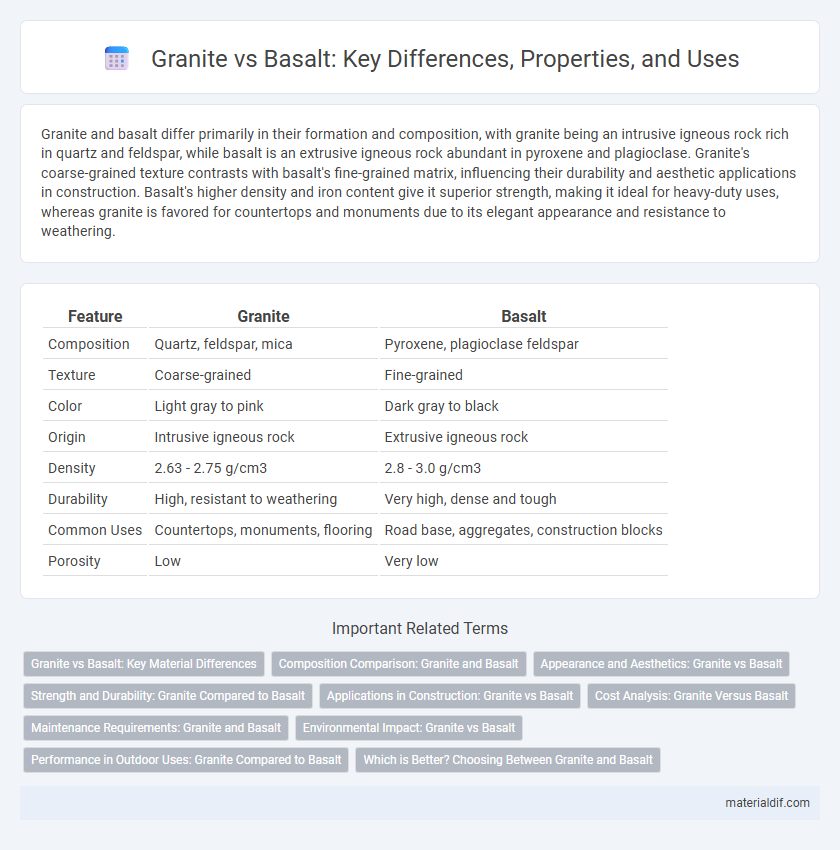Granite and basalt differ primarily in their formation and composition, with granite being an intrusive igneous rock rich in quartz and feldspar, while basalt is an extrusive igneous rock abundant in pyroxene and plagioclase. Granite's coarse-grained texture contrasts with basalt's fine-grained matrix, influencing their durability and aesthetic applications in construction. Basalt's higher density and iron content give it superior strength, making it ideal for heavy-duty uses, whereas granite is favored for countertops and monuments due to its elegant appearance and resistance to weathering.
Table of Comparison
| Feature | Granite | Basalt |
|---|---|---|
| Composition | Quartz, feldspar, mica | Pyroxene, plagioclase feldspar |
| Texture | Coarse-grained | Fine-grained |
| Color | Light gray to pink | Dark gray to black |
| Origin | Intrusive igneous rock | Extrusive igneous rock |
| Density | 2.63 - 2.75 g/cm3 | 2.8 - 3.0 g/cm3 |
| Durability | High, resistant to weathering | Very high, dense and tough |
| Common Uses | Countertops, monuments, flooring | Road base, aggregates, construction blocks |
| Porosity | Low | Very low |
Granite vs Basalt: Key Material Differences
Granite is an intrusive igneous rock composed mainly of quartz, feldspar, and mica, characterized by a coarse-grained texture, while basalt is an extrusive igneous rock consisting predominantly of pyroxene and plagioclase, exhibiting a fine-grained, dense structure. Granite's mineral composition provides higher durability and resistance to weathering compared to the typically more porous and darker basalt. The significant differences in cooling rates result in granite's crystalline texture versus basalt's compact and uniform appearance, influencing their suitability for construction and decorative applications.
Composition Comparison: Granite and Basalt
Granite is an intrusive igneous rock composed mainly of quartz, feldspar, and mica, giving it a coarse-grained texture and high silica content. Basalt, an extrusive igneous rock, is rich in iron and magnesium minerals like pyroxene and olivine, resulting in a fine-grained texture with lower silica content. The contrasting mineral compositions influence their color, density, and durability, with granite being lighter and more resistant to weathering than basalt.
Appearance and Aesthetics: Granite vs Basalt
Granite features a coarse-grained texture with visible quartz, feldspar, and mica crystals, offering a range of colors from pink, white, to gray, contributing to its classic and elegant appearance. Basalt displays a fine-grained, uniform texture with a dark gray to black color, lending a modern, sleek, and minimalist aesthetic. The contrasting visual characteristics make granite ideal for traditional and decorative settings, while basalt suits contemporary designs requiring subtlety and boldness.
Strength and Durability: Granite Compared to Basalt
Granite exhibits remarkable strength and durability, with a compressive strength ranging between 100 to 250 MPa, making it highly resistant to wear and weathering. Basalt, although also strong with compressive strength around 100 to 300 MPa, tends to be denser and harder but can be more susceptible to fracturing under pressure due to its fine-grained texture. The crystalline structure of granite provides superior long-term durability in construction and architectural applications compared to basalt's more brittle composition.
Applications in Construction: Granite vs Basalt
Granite and basalt are widely used in construction, each offering distinct advantages; granite's durability and aesthetic appeal make it ideal for countertops, flooring, and decorative facades, while basalt's high compressive strength and resistance to chemical weathering suit it for heavy-duty applications like road base, concrete aggregate, and railway ballast. Granite's coarse-grained texture and attractive color variations enhance interior and exterior architectural designs, whereas basalt's fine-grained composition provides superior load-bearing capacity and thermal insulation in industrial structures. Understanding these material properties ensures optimal selection for specific construction needs based on performance and visual requirements.
Cost Analysis: Granite Versus Basalt
Granite typically costs between $40 to $100 per square foot, depending on color, quality, and origin, making it more expensive than basalt, which ranges from $30 to $60 per square foot. The higher price of granite reflects its widespread use in premium countertops and architectural features due to its durability and aesthetic appeal. Basalt offers a cost-effective alternative with comparable hardness and strong thermal resistance, favored in industrial applications and modern design projects seeking budget-friendly yet robust materials.
Maintenance Requirements: Granite and Basalt
Granite requires minimal maintenance due to its hardness and resistance to scratches and stains, making it ideal for countertops and flooring in high-traffic areas. Basalt is also durable and low maintenance but may need occasional sealing to prevent moisture absorption and staining, especially in outdoor applications. Both stones offer long-lasting performance, but granite's lower porosity generally reduces the frequency of upkeep.
Environmental Impact: Granite vs Basalt
Granite mining typically results in higher environmental impacts due to extensive quarrying and energy-intensive processing compared to basalt, which is often sourced through more sustainable methods. Basalt's natural abundance and higher durability reduce the need for frequent replacement, minimizing long-term environmental footprint and resource consumption. Both stones, however, have varying ecological effects depending on extraction techniques and local ecosystem sensitivity.
Performance in Outdoor Uses: Granite Compared to Basalt
Granite offers superior durability and weather resistance compared to basalt, making it better suited for outdoor applications such as countertops and paving stones. Its coarse-grained texture and high quartz content provide enhanced resistance to erosion and temperature fluctuations. Basalt tends to be more porous, which can lead to increased susceptibility to staining and weathering over time in outdoor environments.
Which is Better? Choosing Between Granite and Basalt
Granite and basalt both offer excellent durability and aesthetic appeal, with granite known for its coarse-grained texture and wide color range, making it ideal for countertops and decorative interiors. Basalt, formed from volcanic lava, is denser and harder, excelling in outdoor applications such as pavements and building facades due to its superior resistance to weathering. Choosing between granite and basalt depends on the specific application requirements; granite suits detailed indoor designs while basalt provides enhanced strength and longevity for external structures.
Granite vs Basalt Infographic

 materialdif.com
materialdif.com